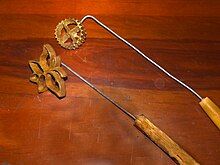Kokis
 A plate of butterfly-shaped kokis | |
| Type | Savoury |
|---|---|
| Course | Appetizer |
| Place of origin | Sri Lanka/Netherlands |
| Main ingredients | Rice flour, Coconut milk |
Kokis (Sinhala: කොකිස්) is a deep-fried, crispy Sri Lankan food made from rice flour and coconut milk. Although considered as a traditional Sri Lankan dish, it is believed to have come from the Dutch.[1] This is an important dish when celebrating Sinhala New Year and plays a major role in the festivities.
Etymology and history
[edit]Although kokis is considered as a traditional Sri Lankan dish, it is believed to be of Dutch origin, from the time when parts of the country were under Dutch rule during the Kandyan period.[2][3] Its name may have been derived from the word koekjes, meaning cookies or biscuits in the Dutch language.[1] The Swedish rosette and the Persian Nan panjereh would be the most similar dishes to the Sri Lankan kokis. The Indian biscuit, Nankhatai, also bears some similarities with kokis.[4] An almost identical snack, Achappam, exists among Christian community in the south west Indian state of Kerala
Significance during the Sinhala new year
[edit]Sinhalese people prepare and consume a number of traditional dishes, including kokis, to celebrate their new year in mid-April.[5] These are traditionally prepared by the women of the household, usually a few days before the new year.[6][7] Nowadays however, they are made mostly by older women, as many people of the younger generation lack the time or the skill and knowledge required to make them due to their busy lifestyles.[8]
Description
[edit]
A special mold of decorative shape such as a flower is used to make kokis. This is called a kokis achchuwa (Sinhala: කොකිස් අච්චුව). It is also called Rosette cookies in English. This mold is coated in a thick batter made from rice flour, coconut milk and beaten eggs. Sugar and salt may be added to the mixture as well. The batter-covered mold is dipped in boiling coconut oil, and the kokis is shaken off the mold and into the oil when it is half cooked and allowed to deep fry until ready. The cooked dish is crispy, and may be served hot or after cooling down. The oil is usually drained on paper before serving.[9][10] It may also be prepared using wheat flour, as an alternative to the traditional rice flour.[11]
Kokis may be consumed as a dessert,[12] and also as an appetizer or snack.[10] It is also commonly served with kiribath and other traditional sweets, which are collectively referred to as sweet eats or rasa kavili (Sinhala: රස කැවිලි), particularly at new year celebrations and other auspicious occasions.[13]
Health effects
[edit]Like most of the traditional Sri Lankan sweet eats, kokis is a food that has a high energy-density.[14] As an oily and fatty food, there is a risk of it causing heart diseases and narrowing of blood vessels.[15]
See also
[edit]References
[edit]- ^ a b Gunasekera, Manique (2005). The postcolonial identity of Sri Lankan English. Katha Publishers. pp. 213, 229. ISBN 9789551115005.
- ^ Sri Lanka. Dept. of Hindu Religious & Cultural Affairs (1991). Sri Lankan culture: a symposium. Dept. of Hindu Religious & Cultural Affairs. p. 19.
- ^ Kelegama, Saman; Madawela, Roshan (2002). 400 years of Dutch-Sri Lanka relations, 1602-2002. Institute of Policy Studies of Sri Lanka. p. 22. ISBN 9789558708132.
- ^ Tirmizi, Bisma (8 October 2015). "Nankhatai: How the subcontinent added its own flavour to the teatime snack". Scroll.in. Retrieved 2021-02-01.
- ^ "The Sinhala and Tamil New Year Customs and rituals". www.news.lk. Retrieved 2021-02-01.
- ^ Galagoda, Sapumali (10 April 2011). "Aluth Avurudu is round the corner!". Sunday Observer. Archived from the original on 24 April 2013. Retrieved 7 April 2013.
- ^ Kannangara, Ananda (8 April 2012). "Tantalising sweetmeats and delicacies". Sunday Observer. Archived from the original on 24 February 2015. Retrieved 7 April 2013.
- ^ Gunasekera, Naomi (14 April 2002). "Sweet past dying fast". Sunday Times. Retrieved 7 April 2013.
- ^ Virmani, Inderjeet K. (1991). Home Chefs of the World: Rice and Rice-based Recipes. International Rice Research Institute. p. 51. ISBN 9789712200236.
- ^ a b George, M. L. C.; E.P, Cervantes (2009). Coconut recipes from around the world. Bioversity International. p. 68. ISBN 9789290438069.
- ^ Abu Bakr, Prasad (15 April 2007). "Rasa Kavili". Sunday Observer. Archived from the original on 24 February 2015. Retrieved 7 April 2013.
- ^ "Sri Lankan cuisine at Hopper Night". Daily News. 20 January 2012. Archived from the original on 3 July 2013. Retrieved 7 April 2013.
- ^ Fernando, Charmaine (13 April 2010). "Aluth Avurudda, promises miracles!". Daily News. Archived from the original on 3 July 2013. Retrieved 7 April 2013.
- ^ Thaker, Aruna; Barton, Arlene (2012). Multicultural Handbook of Food, Nutrition and Dietetics. John Wiley & Sons. p. 96. ISBN 9781118350461.
- ^ Senaratne, Chamindi Dilkushi (2009). Sinhala-English code-mixing in Sri Lanka: a sociolinguistic study. LOT. p. 298. ISBN 9789078328926.
